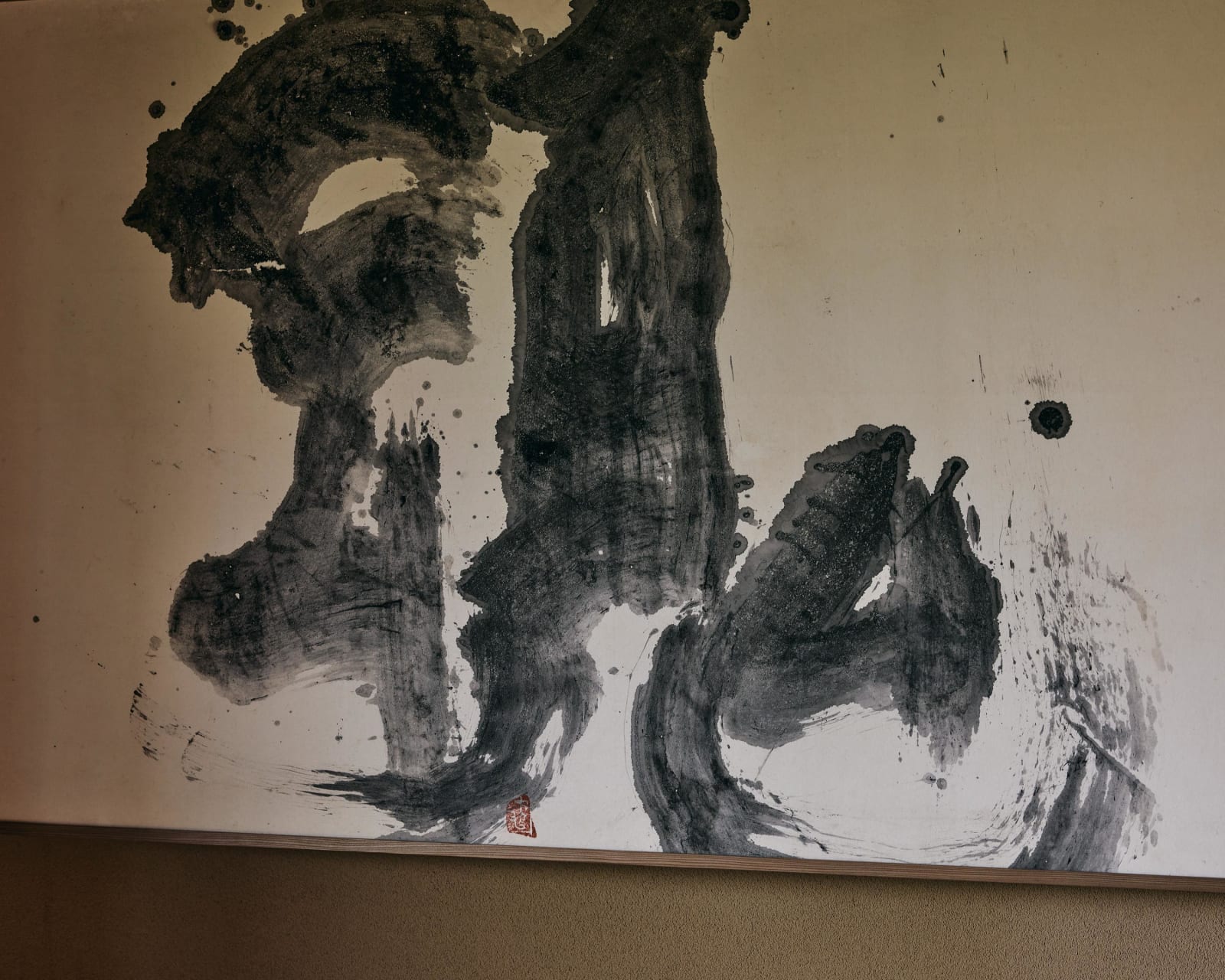Ueda Sōkyū (1899–1968)
Tamashii
Ink on paper, framed
Seal: Kyu
68 x 124 cm
70 x 126 cm (overall)
Seal: Kyu
68 x 124 cm
70 x 126 cm (overall)
Further images
Among the postwar avant-garde calligraphers, Ueda Sokyu was not a radical, but his contributions were critical in paving the way for a new genre of avant-garde calligraphy. Looking over Ueda’s oeuvre—Kanko (freezing river) of 1950, to give an example—one notices that his effort centers on deconstructing, reconstructing, and repositioning characters as conceptual entities rather than descriptive nominators of semantic meaning. With Ai (love) of 1951, Ueda aimed for full independence from the constraints of written language by abandoning the notion of the ideograph altogether. However, from the 1960s onwards, Ueda returned to writing kanji characters under the condition that the manifestation of personal and subjective involvement is as indispensable as the legibility of the character. For instance, Ro ni yoru (inspired by the kanji character “wolf”), one of the exhibits for the touring exhibition Meaning and Symbol: Master of Japanese Calligraphy, demonstrated that legibility and visual expressiveness—wild and ferocious—can coexist in the same character.
The radicals would reject Ueda for seeking compromise with the traditionalists. But Ueda opted for, as a matter of fact, an eclectic visual philosophy that eschewed simple reliance on the fast gesture of “self-expression” and the obligation to the semantic meaning of kanji character at the same time. In a speech during his travels in Europe in 1966, he declared that “the ultimate goal of the art of calligraphy is to represent the inward emotion;” he came to the conclusion that “In calligraphy, one cannot just content oneself with converting the meaning of characters to outward form. Artistic expression begins when you inject them with emotion that the reader will be able to understand.” He sought to visualize his intangible emotion—a concept deeply ingrained in Asian tradition and aesthetics—through kanji characters, thereby appealing to his audiences both in the East and in the West.
Tamashii is the third and the last piece stemming from the same collection as Kan and Work, which both appeared in previous Wanobi catalogs. The work is also included in archival film footage from the Bokujinkai group made to introduce its members and affiliated artists to the European art community. As Ueda explained to his European audience, Tamashii (soul, spirit) was a representation fertile with the artist’s emotion and passion for calligraphy.
Ueda Sokyu (calligrapher; 1899–1968)
Calligrapher born in Hyogo Prefecture. Sokyu studied calligraphy with Ibara Ungai and Hidai Tenrai. In 1933, he co-founded Shodo Geijutsusha (Art of Calligraphy association) and became the chief editor of their journal Shodo Geijutsu. With his work spanning the pre- and postwar eras, Sokyu was an important mentor for Inoue Yuichi and Morita Shiryu of Bokujin-kai and is regarded as a leader of postwar avant-garde calligraphy in Japan.
The radicals would reject Ueda for seeking compromise with the traditionalists. But Ueda opted for, as a matter of fact, an eclectic visual philosophy that eschewed simple reliance on the fast gesture of “self-expression” and the obligation to the semantic meaning of kanji character at the same time. In a speech during his travels in Europe in 1966, he declared that “the ultimate goal of the art of calligraphy is to represent the inward emotion;” he came to the conclusion that “In calligraphy, one cannot just content oneself with converting the meaning of characters to outward form. Artistic expression begins when you inject them with emotion that the reader will be able to understand.” He sought to visualize his intangible emotion—a concept deeply ingrained in Asian tradition and aesthetics—through kanji characters, thereby appealing to his audiences both in the East and in the West.
Tamashii is the third and the last piece stemming from the same collection as Kan and Work, which both appeared in previous Wanobi catalogs. The work is also included in archival film footage from the Bokujinkai group made to introduce its members and affiliated artists to the European art community. As Ueda explained to his European audience, Tamashii (soul, spirit) was a representation fertile with the artist’s emotion and passion for calligraphy.
Ueda Sokyu (calligrapher; 1899–1968)
Calligrapher born in Hyogo Prefecture. Sokyu studied calligraphy with Ibara Ungai and Hidai Tenrai. In 1933, he co-founded Shodo Geijutsusha (Art of Calligraphy association) and became the chief editor of their journal Shodo Geijutsu. With his work spanning the pre- and postwar eras, Sokyu was an important mentor for Inoue Yuichi and Morita Shiryu of Bokujin-kai and is regarded as a leader of postwar avant-garde calligraphy in Japan.





